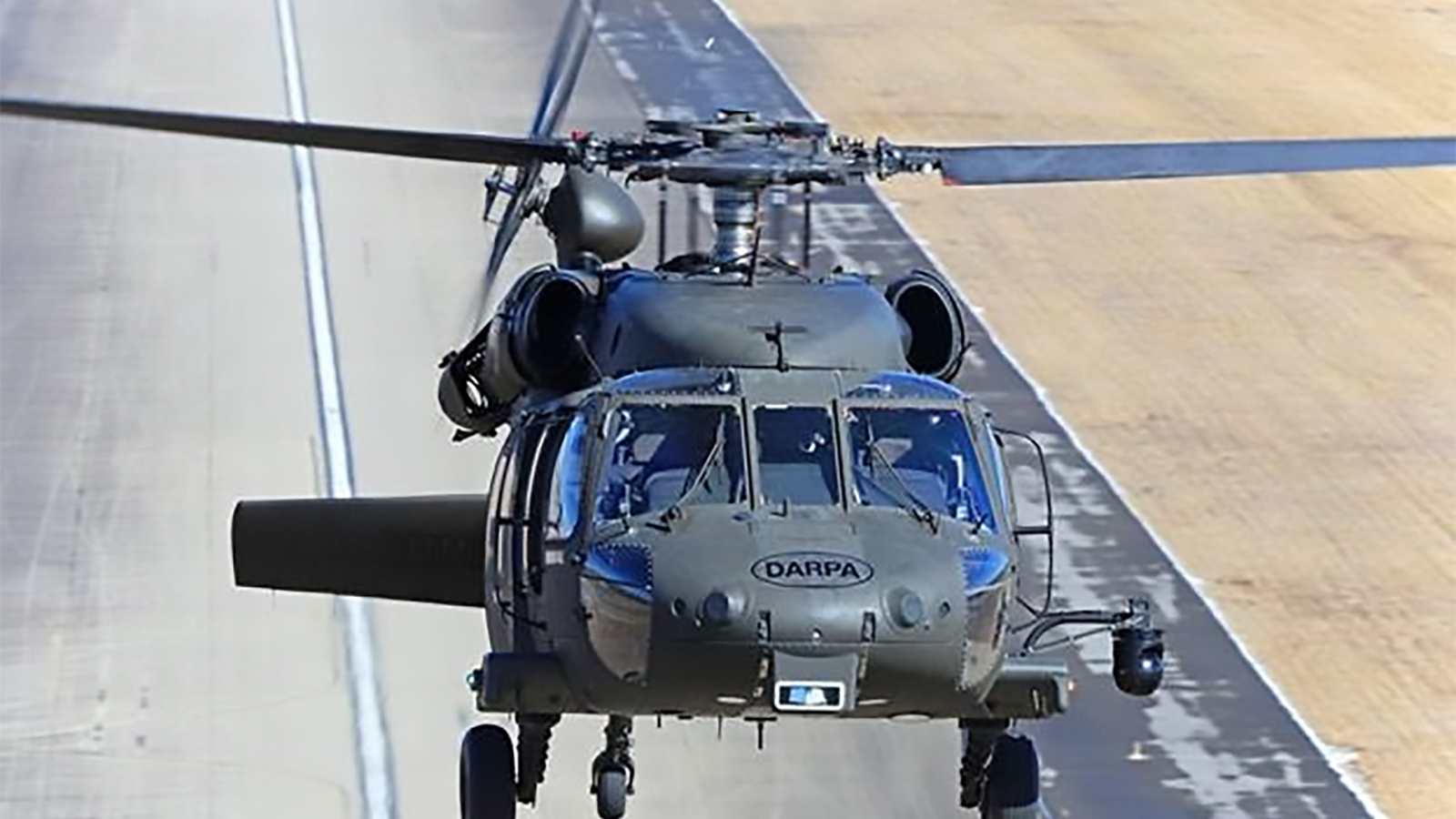
DARPA’s Aircrew Labor In-Cockpit Automation System program completed the first flight without a pilot onboard an UH-60A Black Hawk helicopter. (Image courtesy of DARPA)
AAAA: Months after a Sikorsky UH-60 Black Hawk demonstrated a fully unmanned flying capability, Army aviation leaders are taking a circumspect approach to autonomous rotorcraft, saying they don’t predict they’ll abandon human pilots for most missions anytime soon.
Rather, Army officials expressed interest in specific use cases for autonomous flights, like flying supplies into contested territory.
“When we take a look at our weapon systems of the future, the first step is minimally manned,” Gen. James C. McConville, chief of staff of the Army, said Monday at the Army Aviation Association of America (AAAA) conference in Nashville, Tenn. “I have a hard time believing we’re going to have 35 Rangers in the back of an aircraft and they’re going to go up and knock on the door of the cockpit and there’s no one in there.”
The prospect of unmanned chopper operations was raised in February when, under a DARPA program called Aircrew Labor In-Cockpit Automation System (ALIAS), a UH-60A Black Hawk flew over Fort Campbell, Ky., for 30 minutes with no humans on board using Sikorsky’s Matrix autonomous flight software and remote piloting from the ground. The ALIAS has previously completed autonomous resupply missions at Project Convergence in November at Yuma Proving Ground, Ariz., though with safety pilots onboard.
“What that DARPA project has demonstrated is that autonomous flight is in fact possible,” Maj. Gen. David Francis, Army Aviation Center of Excellence and Fort Rucker commanding general, said at a roundtable at the AAAA conference. “What that does for us is it opens up all kinds of possibilities for the development of future vertical lift and other capabilities that we may want to pursue in the future.”
But right now it’s still not clear how the Army will use the autonomous flight, in part because it’s a nascent technology. The DARPA program is continuing, but Maj. Gen. Walter Rugen, director of the Future Vertical Lift Cross-Functional Team, said that the Army hasn’t decided on transitioning the program.
“That analysis is ongoing so there’s been no decision,” Rugen told reporters at the roundtable.
He said the Army is also exploring an “emerging requirement” for unmanned logistics missions. Rugen noted the importance of independent tech readiness assessments and said that the service’s capabilities and concept developers were sifting through data to make sure the Army is “going down the right path” on autonomous flight.
Autonomy Working With Pilots
Where autonomous tech could play a more immediate part, Rugen said, was in assisting on-board pilots to reduce cognitive burden. He said the service is “very interested” in what can be automated in “the process of our typical missions and our typical doctrinal tactical tasks.”
Autonomy — either full or partial — will play an important role in future operations for pilots, who will likely have to manage unprecedented amounts of data flowing into their cockpit, be it joint fires data coming in, or data feeds from an air-launched effect fired out ahead to scout.
“I remember in Iraq and Afghanistan with the amount of information coming in with all the radios and sensors, it can be overwhelming,” said Jay Macklin, a former Black Hawk pilot and current Sikorsky director for Army future vertical lift and innovations strategy and business development. “So this just gives the commander another tool to reduce risk and increase mission accomplishment. And the Army will decide, you know, what level that is.”
The autonomous flight software could also help pilots fly in poor visibility conditions, potentially saving lives, Macklin said.
To that end, the Army is currently upgrading its current Black Hawk fleet with modernized cockpits, integrating a digital cockpit during conversions of UH-60 Lima Black Hawk’s into upgraded Victor models. DARPA also said in a press release in February that the autonomous flight software from Sikorsky would be used on a UH-60 Mike version with fly-by-wire software.
Between Pilots And Robots, Finding The ‘Middle Ground’
In total, Sikorsky has 265 flight hours on its fully autonomous Black Hawk software, according to Nathalie Previte, vice president of Army and Air Force Systems at Sikorsky. Its last flight was the February pilot-less demonstration, but it has more planned. Sikorsky officials mentioned that their autonomous helicopter has been invited to Project Convergence 22 after successful demonstrations at PC21 last year.
In those later flights, Sikorsky will likely attempt to demonstrate other use cases for fully autonomous flights. For instance, Previte said the company is looking at the autonomous Black Hawk for medical evacuation missions, which requires new software.
Like the Army officials, Macklin said he doesn’t predict the Army will abandon pilots, but will instead find a compromise where autonomous choppers can relieve some operational burden or fly into especially dangerous situations.
“It probably will end up somewhere in the middle,” Macklin said, of the Army’s pilot-to-autonomous balance.
Now it’s just a matter of the Army deciding how far it wants to go.
“We see it as a great technology. It’s certainly something that we will continue to watch, develop and then what we want to do is be able to affordably bring it onto our platforms as the technology matures,” said Brig. Gen. Robert Barrie, commander of Program Executive Office Aviation.






















